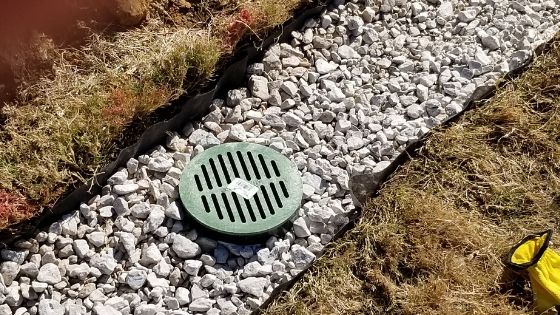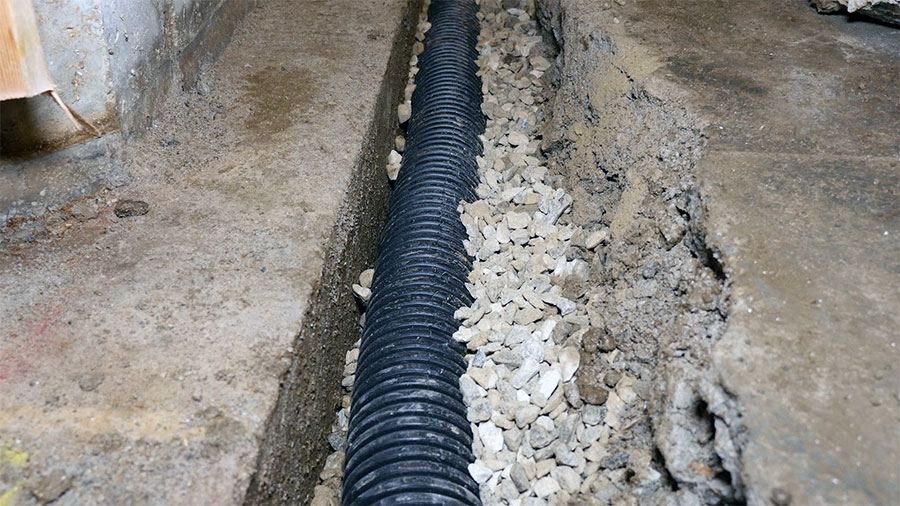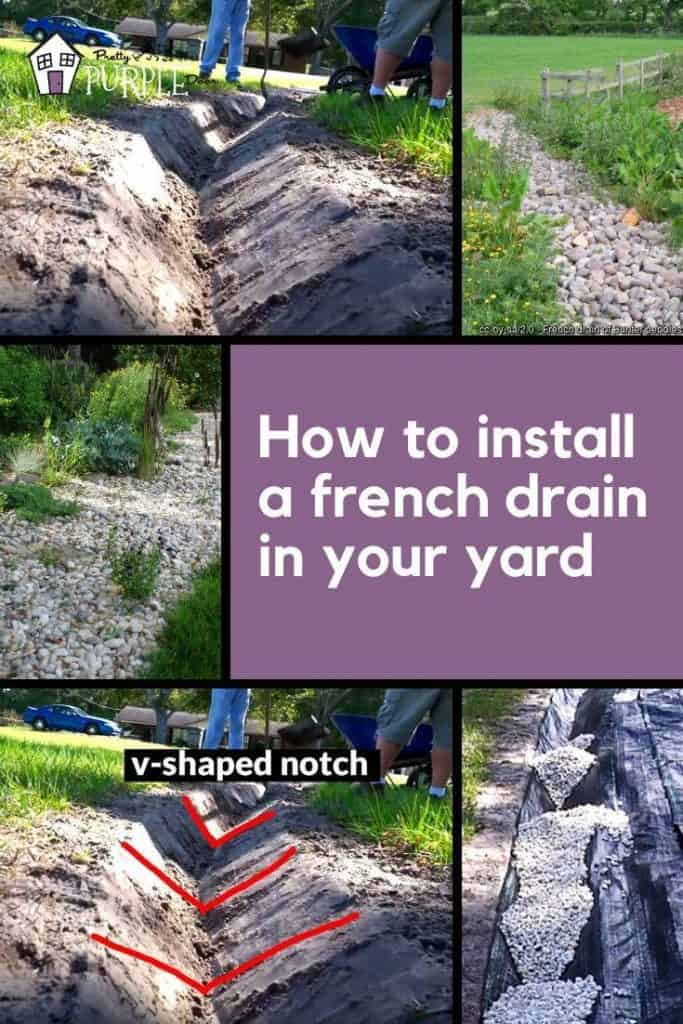Evaluating DIY vs. Professional Portland French Drain Setup
Evaluating DIY vs. Professional Portland French Drain Setup
Blog Article
Recognizing the Perks and Installment Refine of a French Drain for Homeowners
A French drainpipe can be the solution you need if you're dealing with water merging around your home. It redirects excess dampness away from your structure, assisting to avoid expensive damages and mold and mildew problems. Prior to you jump into installation, it's crucial to understand the benefits and the steps entailed. Allow's check out exactly how to analyze your home and what devices you'll require to get begun.
What Is a French Drainpipe?
A French drainpipe is a reliable remedy for taking care of excess water in your yard. It's a trench loaded with gravel or rock that contains a perforated pipeline at its bottom. This style permits water to move right into the pipeline as opposed to merging around your home, preventing flooding and disintegration. When you observe water building up in particular locations, a French drain can reroute that moisture far from your foundation and other vital areas.Installing one entails excavating a trench that slopes far from your home, making sure reliable water drain. You'll require to line the trench with landscape material to avoid soil from obstructing the gravel. Once you've put the pipe and covered it with gravel, the system will effectively direct water away. This straightforward yet effective drain option can help secure your residential or commercial property from water damage and maintain the honesty of your landscape.

Trick Advantages of Setting Up a French Drain
Setting up a French drain can substantially enhance your building's drain system, specifically if you frequently deal with water pooling in your backyard. Among the vital benefits is that it successfully redirects excess water away from your home's structure, lowering the risk of water damages and mold development. This can save you from pricey fixings down the line.Additionally, a French drainpipe can boost your yard's total aesthetic appeals by protecting against unsightly puddles and sloppy locations. With much better drain, you can appreciate a much more usable exterior room for activities and gardening.Moreover, these drains pipes can boost your home's value. Potential buyers value a well-drained yard, as it indicates less upkeep and less issues. French drains need very little maintenance-- simply occasional cleansing to assure they function correctly. By spending in a French drain, you're making a clever choice for both your home and your satisfaction.
Assessing Your Home for Drainage Issues
Before you can successfully attend to drainage problems, it's vital to analyze your residential or commercial property completely. Start by strolling around your yard after a heavy rainfall to determine problem locations. Search for standing water, soaked patches, or disintegration, as these indicators show inadequate water drainage. Focus on how water streams on your property; observe if it accumulates near your foundation or in low-lying areas.Next, examine your seamless gutters and downspouts. Verify they direct water far from your home and that they're without debris. Examine your landscaping, as specific plants can add to drainage issues by taking in too much water or developing barriers.Finally, think about the incline of your backyard. Ideally, your land should incline away from your foundation. If you discover any kind of problems, bear in mind; this will aid you establish the very best water drainage services, like mounting a French drain, in the future.

Tools and Materials Needed for Installment
When you've identified the drainage issues on your residential or commercial property, collecting the right devices and materials for a French drain setup comes to be the following step. You'll require a shovel or trenching device to dig the trench for your drain. A level will aid ensure the trench inclines properly, advertising proper water flow.For materials, acquisition perforated PVC pipe to permit water to get in while staying out dirt. You'll likewise require crushed rock to surround the pipeline, assisting drainage and stopping clogging. Landscape design material is vital to maintain dust out of the crushed rock and pipe.Don' t neglect safety equipment like gloves and safety glasses for defense while you work. If you prepare to attach your French drainpipe to a sump pump, assurance you have the required fittings and a pump on hand. With these materials and tools, you'll prepare to tackle your French drain setup efficiently.
Step-by-Step Setup Refine
Since you've collected your products and tools, it's time to get going on mounting your French drainpipe (Portland French Drain). You'll require to concentrate on trenching and correct drain placement to guarantee effective water management. Backfilling and finishing the last actions will wrap up your task nicely.
Required Devices and Materials
To successfully install a French drain, you'll need a couple of necessary devices and products at hand. Beginning with a shovel or a trenching tool to dig your trench. A level's vital for guaranteeing correct slope, while a measuring tape helps you determine distances accurately. You'll additionally need perforated pipeline, which is the heart of the system, and crushed rock or rock for drain. A landscape textile will protect against soil from blocking the drain. Don't fail to remember a wheelbarrow for delivering materials and safety and security gear like safety glasses and handwear covers. Ultimately, a pickaxe can be helpful for breaking up hard soil. Collect these items before you begin, and you'll be established for a smooth installation process.
Trenching and Drain Placement
As you prepare to install your French drainpipe, the initial step includes thoroughly excavating the trench where the drain will certainly be put. Beginning by noting the desired course with spray paint or string, guaranteeing it has an incline of a minimum of 1% for correct drainage. Using a shovel or trenching device, dig a trench regarding 6 inches wide and 18 to 24 inches deep. Get rid of any type of rocks, roots, or particles as you go. As soon as the trench is prepared, line it with landscape design fabric to stop soil from obstructing the drainpipe. Next, place a layer of gravel at the base for drainage support. Place the perforated drainpipe pipeline in the trench with the openings dealing with down, ensuring it's lined up with the incline for ideal water flow.
Backfilling and Final Steps
It's time to backfill the trench once you have actually put the perforated drainpipe pipeline and covered it with crushed rock. Beginning by adding a layer of soil in addition to the crushed rock, making sure to prevent huge globs or rocks. Rake or utilize a shovel to uniformly disperse the soil, filling the trench to the surface level. It's vital to compact the soil lightly as you go to prevent future settling. After backfilling, smooth out the surface, blending it effortlessly with the bordering area. Take into consideration including topsoil for far better development if you're preparing to plant lawn or various other plant life. Lastly, look for any kind of drain concerns, and tidy up your workspace, making sure everything looks useful and neat.

Upkeep Tips for Your French Drain
While maintaining your French drainpipe could appear tough, it's essential for preventing water accumulation and guaranteeing reliable drainage. Routinely check the drain's outlet for particles like fallen leaves, dust, or other obstructions. If you discover a blockage, clear it out promptly to stay clear of backups (Portland French Drain).Next, inspect the crushed rock bordering the drain. If you see a substantial quantity of sediment accumulation, think about cleansing or replacing the gravel to preserve peak performance.Additionally, check the area around your French drain for indicators of disintegration or settling. If you identify any type of issues, do something about it to repair them, as they can impact drainage efficiency.Lastly, consider examining the drain's efficiency after heavy rains. It may be time to reassess your system if water pools close by. By complying with these maintenance pointers, you'll ensure your French drainpipe remains to work successfully and shields your home from water damages
When to Call a Specialist for Aid
You ought to take into consideration calling a professional if you notice indications of drain issues, like persistent standing water or overruning seamless gutters. Facility setup requirements can also signify that it's time to get skilled assistance, specifically if you're unsure concerning regional security policies. Do not be reluctant to reach out for assistance to ensure your French drainpipe features effectively and fulfills code.
Indications of Drain Issues
When drain problems occur, acknowledging the indicators early can save you from expensive fixings down the line. Seek water merging in your yard or around your foundation; this can indicate a clog. It's a certain sign that drain isn't functioning effectively if you observe persistent wetness in your basement. Keep an eye out for nasty odors, which can stem from stationary water or decomposing particles in the drainpipe. You could hear uncommon gurgling sounds from your pipes, showing a clog in the system. If you identify erosion or sinking soil, it's time to act. Don't hesitate to call a professional to examine the situation and protect against additional damages to your home.
Complicated Installment Needs
If you're thinking about setting up a French drain, comprehending the complex installation requirements is crucial for why not try this out assuring its efficiency. French drains frequently entail excavation, sloping, and proper water drainage materials, which can be overwhelming. It's smart to call an expert if your yard has tough surface or you're unclear concerning neighborhood dirt conditions. They can evaluate your home and figure out the most effective method. Furthermore, if you lack the necessary devices or experience, hiring a professional can save you time and stress. A professional can also ensure the drain is set up to function correctly and last for many years. Eventually, spending in professional help can stop costly errors and assure your French drain runs successfully.
Safety and Regulations Compliance
While intending your French drain setup, it's important to focus on security and stick to local regulations. Prior to you start excavating, check if you require a permit or if there specify codes in your location. This assures find you're not breaking any laws that could bring about penalties or task delays.If you're unsure regarding below ground utilities, call a professional to situate them. It's important to prevent harmful gas, water, or electrical lines. Additionally, if the setup needs heavy machinery or challenging grading, employing a specialist can conserve you effort and time. Remember, safety precedes-- don't be reluctant to look for help if you feel overwhelmed or uncertain concerning the process. Doing so protects your building and assures an effective drainage solution.
Frequently Asked Questions
Can a French Drain Help With Cellar Flooding Problems?
Yes, a French drain can efficiently reroute water away from your basement, decreasing flooding problems. By setting up one, you'll handle excess water far better and shield your home from prospective water damages and mold and mildew growth.
How much time Does a French Drainpipe Typically Last?
A French drain typically lasts around 30 to 40 years, relying on the products used and maintenance - Portland French Drain. Routine assessments and proper care can help prolong its lifespan, making sure reliable drain for your residential property
Are There Alternatives to a French Drainpipe?
Yes, there are alternatives to a French drain. You could think about surface drains pipes, dry wells, or grading your lawn to reroute water. Each option has different effectiveness, so evaluate your particular drain requires prior to deciding.
Will a French Drainpipe Impact My Home's Landscape?
A French drain can modify your property's landscape by redirecting water circulation and possibly transforming soil moisture degrees. However, with careful planning, you can maintain aesthetics while boosting drainage and preventing water damage.
Can I Set Up a French Drainpipe in Winter Months?
Yes, you can mount a French drain in winter, but you'll need to take into consideration icy ground conditions. Ensure you've the right devices and products to handle any kind of difficulties posed by the winter. When you discover water additional hints accumulating in particular locations, a French drainpipe can redirect that moisture away from your foundation and various other vital areas.Installing one includes digging a trench that slopes away from your home, making certain efficient water drainage. Mounting a French drain can greatly improve your home's water drainage system, especially if you commonly deal with water merging in your yard. As you prepare to install your French drain, the first action involves very carefully excavating the trench where the drainpipe will certainly be put. While maintaining your French drain might appear difficult, it's critical for protecting against water build-up and guaranteeing effective drain. A French drainpipe can modify your building's landscape by rerouting water flow and possibly transforming dirt dampness levels.
Report this page